 "QUANTUM SHOT" #449 "QUANTUM SHOT" #449link 10 creatures, each one step short of an alien life form You've seen some weird marine creatures in our previous articles "Out-of-this-world Fishing" and "Big Fish Extravaganza". Now we present more, and probably the weirdest bunch yet. Article is based on material from Chan Lee Peng, written by Avi Abrams. They exist. Don't ask "why", just accept their unbelievable strangeness and the fact that other surreal creatures (who knows how many!) may inhabit the oceanic depths, of which we have only explored a tiny fraction. 1. Leafy Sea Dragon Whatever you do, don't put it in your salad.  (image credit: Jeffrey N. Jeffords) 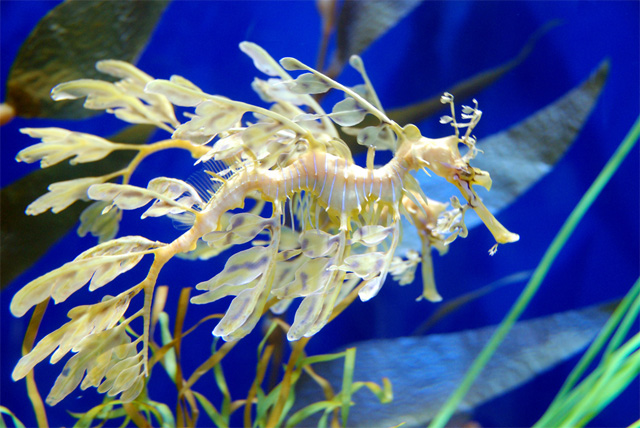 (image credit: Namisan) A leafy sea dragon (phycodurus eques) has long leaf-like protrusions all over its body, serving as camouflage among different types of floating seaweeds or kelp beds. Neither prey nor predators recognize it as a fish. 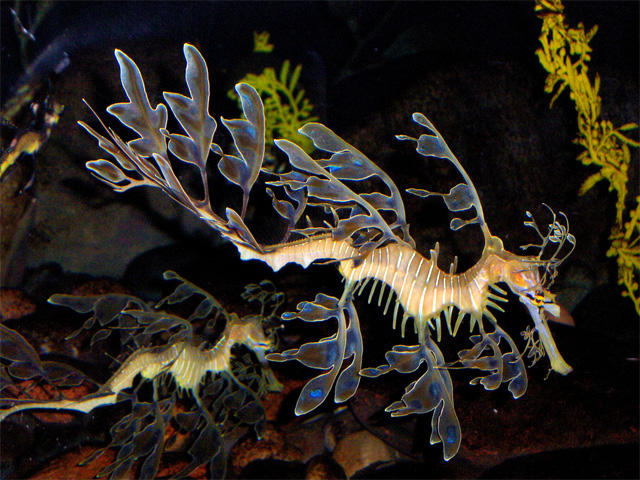 (image credit: Steve) It's found along the coastline of Australia; a fully grown leafy sea dragon can reach about 45cm (18in). During mating, the female deposits up to 250 bright pink eggs onto a special "brood patch" on the underside of the tail of the male where they are attached and fertilized. 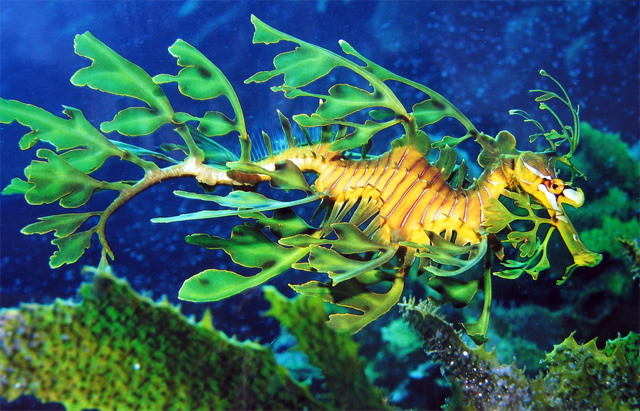 (image credit: James D. Watt/J.H. Editorial, via) A most distinguished portrait, worthy to be framed: 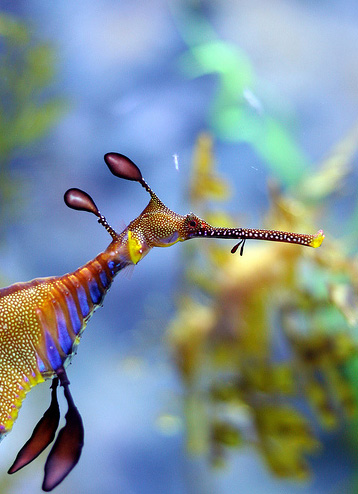 (image credit: nas-city) 2. Umbrella Mouth Gulper Eel Here is a creature from the underwater gates of hell. 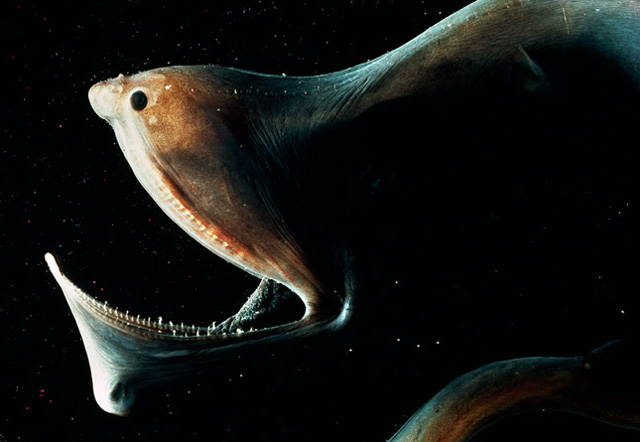 (image credit: Bruce Robison) The umbrella mouth gulper eel (eurypharynx pelecanoides) can open its "umbrella mouth" to pelican-like proportion, accommodating prey much larger than its size.  (images credit: John Kealy and captbluefin) Plus it can stretch and expand its stomach! The eel itself can be almost one meter in length, and if it starts expanding... This means it can swallow and devour something more than 1.5 meters long (keep your favorite cat away from it) 3. Firefly Squid This squid sees the world in color. And it makes deep-blue pretty light itself. 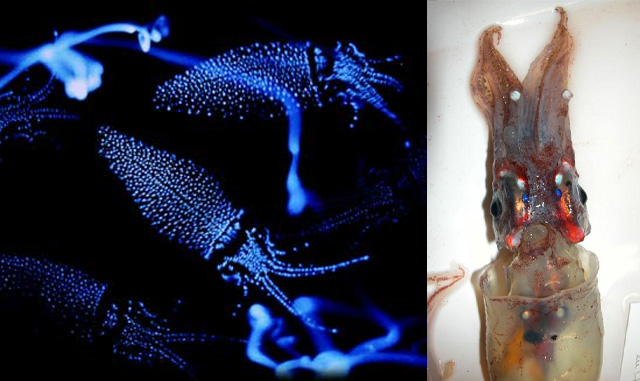 (image credit: Phil Livelsberger) The firefly squid (watasenia scintillans), also called the sparkling enope squid has special deep-blue light producing organs called photophores - by flashing the lights on and off, it can attract prey before trapping it with its tentacles. It's also only cephalopod species which have color vision!   (images credit: pinktentacle) Each year off the coast of Toyama Bay, Japan, billions of these tiny squids will gather to spawn, creating a cool lights show, see above. Boiled firefly squids is also a common food item in Asia:  (image credit: Lulu Durand) 4. Viperfish Now we come to the section featuring deep sea beauties. Hold on to your breakfast, these guys are uglier than the current American stock market situation.  (images credit: David Forcucci, wolaver) The viperfish (chauliodus sloani) can grow to over half a meter in size... which is simply NOT a comforting thought. Again, it attracts its prey with luminescent spots running from throat to tail... and attracts curious humans, who can not refrain from sticking a finger in its jaws to see what happens. 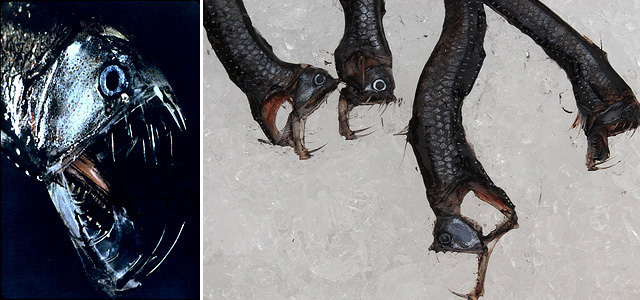 (image credit: kccornell) Luckily for everybody involved, it can go without food for days. Beware of the sharp fangs, even if it's dead - 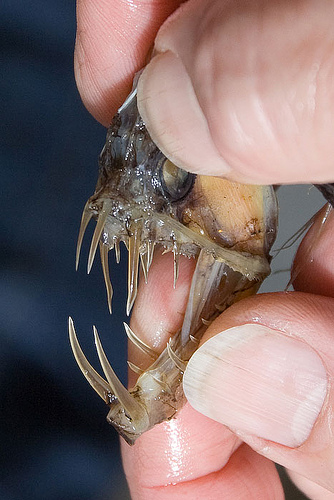 (image credit: Neil Creek) Are you ready for another nauseating shot? We warned you... Here is an angler fish - with its stomach in its mouth (decompression caused the stomach to invert). 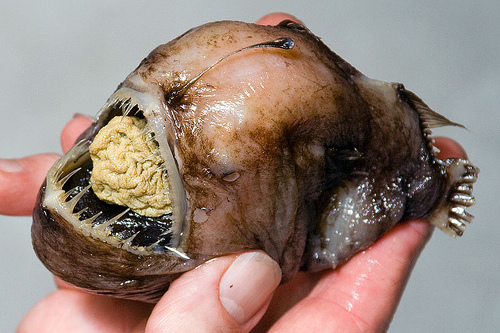 (image credit: Neil Creek) Update (thanks, Scubaman5000) "If that wasn't enough... here is how angler fish mate: The male who is a lot smaller than the female bites into her and he actually becomes fused to the female for the rest of his life. In deep water environments this allows them to have a higher success rate in breeding where finding a mate can be difficult" 5. Fangtooth, or Ogre Fish Winner of the Deep Abyss Beauty Contest last year.  (image credit: Shane Warne) A Fangtooth (anoplogaster cornuta), or ogre fish, dwells mostly in the waters off the coast of Australia... by the way, the waters off Australia seem to teem with all kinds of monsters. It may be ferocious-looking, but it's actually quite small - a maximum length of 17cm. 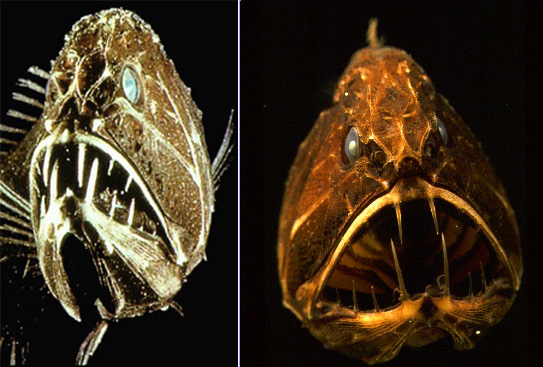 (images credit: Kim Jinsuk, Norbert Wu) Its head contains several mucous cavities separated by serrated ridges (I like how this sentence sounds). Its lower teeth are engineered to neatly slide into mouth pockets, when the fish decides to close the gaping jaw (see photo to prove it here) It is one of the deepest living organisms found yet; it seems to enjoy water temperatures near freezing state. And no, it does not like you, either. 6. Hatchetfish They know what you did last summer.  (image credit: reefnews) A hatchetfish has extremely thin body, resembling the blade of a hatchet, and tubular large eyes that are permanently fixed looking upwards - this helps them to search for food falling from above. It also gives them a psychotic look, with eyes rolled up and stuck there. 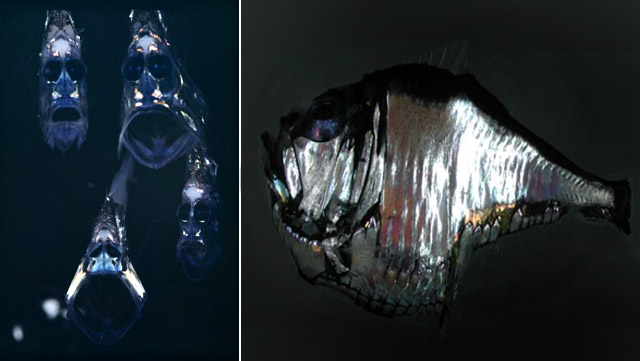 (image credit: oceanexplorer) These guys only look ugly. Inside them hides a gentle, forgiving soul, desperately wanting to cuddle up... yea, right. 7. Christmas-Tree Worm Here is something beautiful to feast your eyes on. 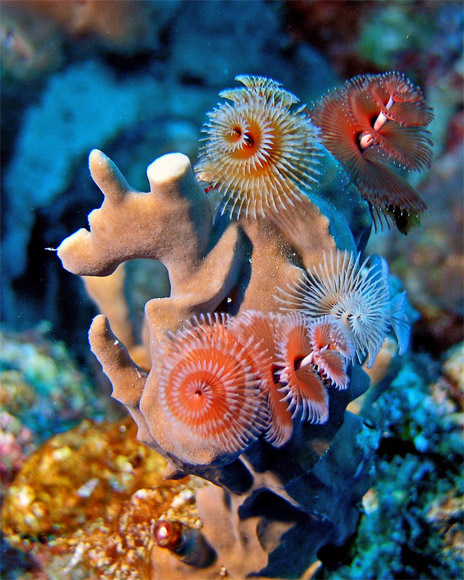 (image credit: José Eduardo Silva)  (image credit: Peter Forster) The christmas-tree worm (spirobranchus giganteus) is a small polychaete worm most often found in the Black Forest Reef and other reefs near Grand Turk. They hide in the tubes, stick out their heads, and when threatened, pull their heads back into the tube. The feather-like tentacles resembling twin "Christmas trees" are called radioles - they filter the plankton for food, aid in respiration, and allow this worm to sing Christmas carols, very very softly. 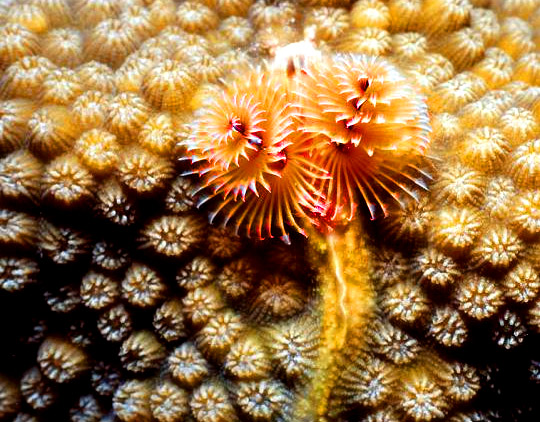 (image credit: reefnews) 8. Giant Basket Star A tangled wonder among the reefs. Just don't ask what's inside of it. 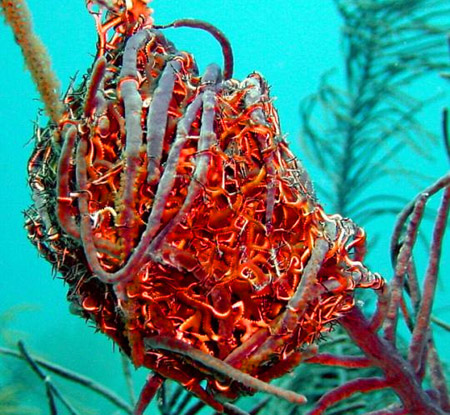 (image credit: Ellen Muller) 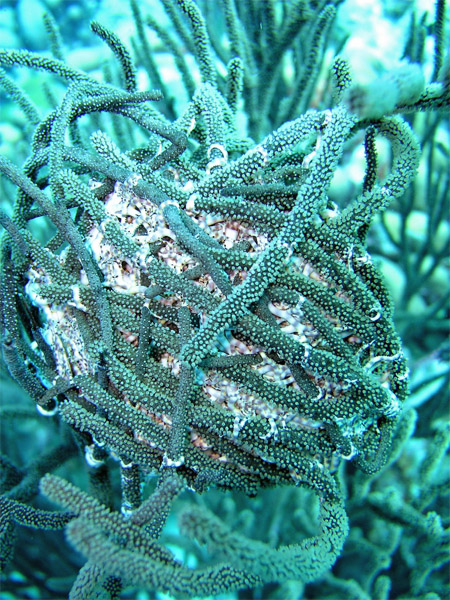 (image credit: Happy Mermaid) The giant basket star (astrophyton muricatum) is an early Mesozoic invertebrate, often found around British Virgin Islands. During the day, it curls up into a tight ball shape to protect itself from predators. At night, it climbs to an elevated point to feed on plankton by extending its intricately-branched feeding arms in a bowl-like shape. Then, it coils around its prey and the tiny hooks along the length of these arms will prevent its prey from escaping. Sounds like a healthy "Blob" feeding habits. Here is another variety of Astrophyton, simply astounding in its classical beauty: 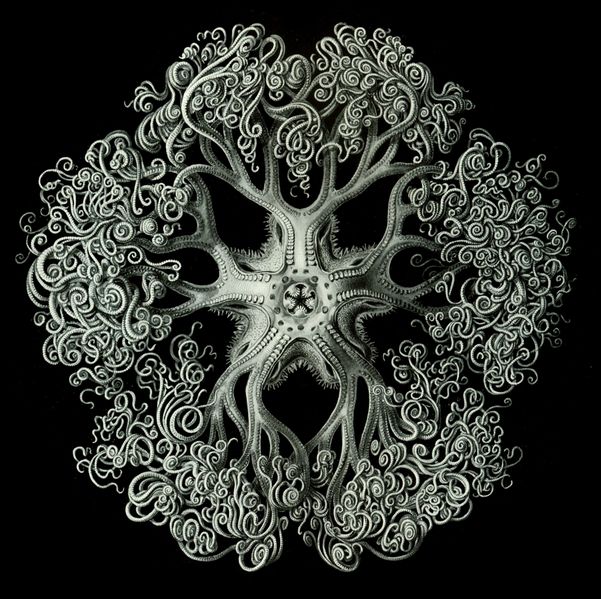 (image credit: Haeckel, Ophiodea) 9. Furry Sea Cucumber If it's not furry, and it's not a cucumber, then what on Earth is it?  (images credit: Sean, Nathan Browm) The furry sea cucumber (astichopus multifidus) can be seen crawling or rolling over the sea floor of the Caribbean, Bahamas, and Florida. If you tear it to pieces trying to find out what on Earth is it, it would not really mind. They can regenerate their body tissues... potentially filling the ocean floor with furry cucumbers - what a thought. The "Furry Cucumber" name, somehow, perfectly fits this deeply Salvador Dali-esque creature. 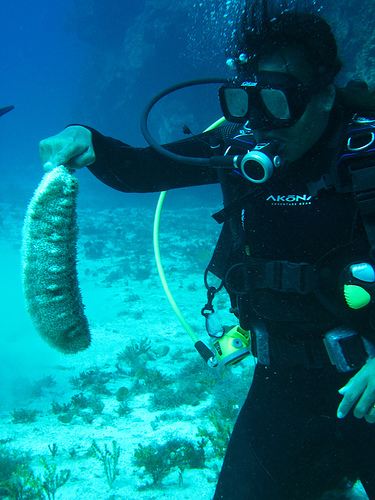 (image credit: Lee Boxall) And finally, perhaps the prettiest of them all - 10. Flamingo Tongue Snail Flamingos don't have a tongue like that, in case you were wondering. 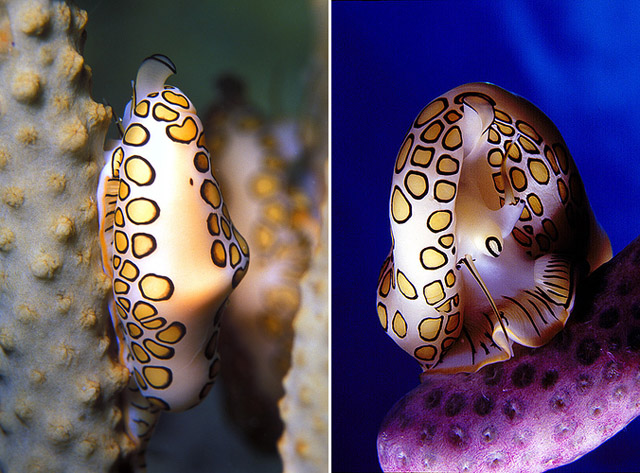 (images credit: Laszlo Ilyes and Courtney Platt) The flamingo tongue snail (cyphoma gibbosumn) is a small, colorful sea snail which lives on various species of soft corals in the Caribbean. This creature almost-literally wears its heart (soul and colors) on its sleeve... - The pretty color you see in these images - is not in snail's shell! Rather, it's in a layer of live mantle tissue, connected to its foot - the snail pushes it out to cover the shell. The mantle tissue also works like a fish's gill. When the snail is attacked, the mantle (and colors) are withdrawn. So you might say, this is the only marine animal that literally turns pale in fright. 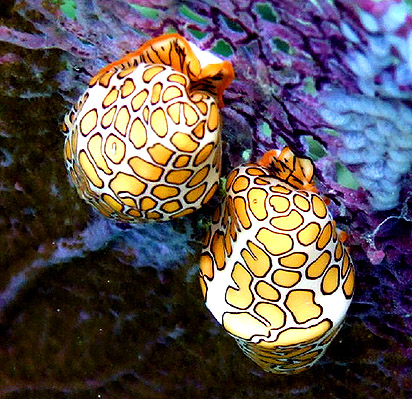 (image credit: Doug Finney) And they're only beautiful (with all that color) while they're alive. The dead ones are just ugly white shells... BONUS: A Piglet Squid (Helicocranchia) caught off the shores of Nigeria. Finally a face you can trust.  (image credit: Allan Kinnear) CONTINUE TO OTHER PART OF THE SERIES! - "Out-of-this-world Fishing" Also read "Big Fish Extravaganza"! Permanent Link...  ...+Facebook ...+Facebook Category: Nature,Animals |
Kamis, 17 Juli 2008
Odd-Looking Marine Animals
Langganan:
Posting Komentar (Atom)
Tidak ada komentar:
Posting Komentar